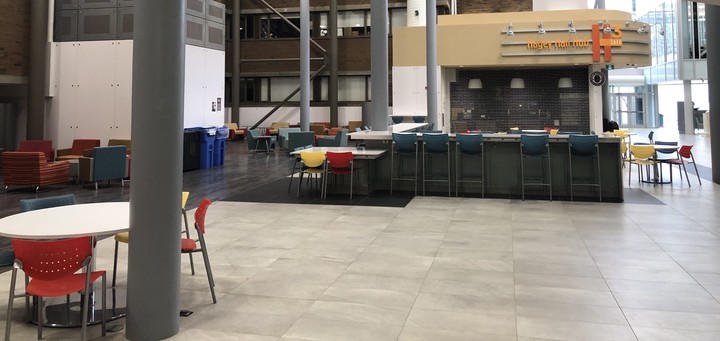Emergency Remote Teaching: A Post Secondary Reality Check
 The empty Hagey Hall of the Humanities atrium at the University of Waterloo on March 18th, 2020
The empty Hagey Hall of the Humanities atrium at the University of Waterloo on March 18th, 2020Cross-posted from ActiveHistory.ca
They fell like dominoes throughout the week as the implications of the COVID-19 pandemic became unavoidably clear: first, Laurentian University suspended classes and moved them online on Wednesday, March 11th; by the evening of Friday, March 13th, every university in Ontario had suspended in-person classes and declared that winter term classes would be completed online (or via other alternative means). We are about to see Ontario engage with technology-mediated learning on an unprecedented scale.
The warning bells are chiming. Some faculty are wary. The Canadian Association of University Teachers, for example, warns against workload pressures that would now require “additional support for staff, such as assigning teaching assistants,” and cautions that academic bodies “involved in monitoring the pedagogical effectiveness of temporary online instruction and to decide on adjustments or discontinuance.”
Dipping one’s toes into Twitter and you’ll see rhetoric as varied as how this devalues the hard work of online education, that it is an impossible task being given to instructors, and – in conspiratorial tones – how this might just be the first herald of a “neoliberal” move towards online education. Naturally, nobody would argue that any of this was ideal.
Framing this as a move to “online education,” however, is deeply misleading.
I am currently teaching a fully-online course at the University of Waterloo). While teaching this course involves quite a bit of work, the vast majority of labour came at the front-end: designing online content to meet learning objectives, ensuring the accessibility of content, working with top-notch instructional designers to produce clear visuals and effective discussion forums alike.
Indeed, at the University of Waterloo, we generally treat preparing an online course in our workload as if we were teaching an in-person class; meaning that the whole process of creating a new online course and teaching it is recognized as more work than delivering a traditional on-campus course.
In my own case, taking a course that I had already taught in-person took about one full eight-hour day a week for six months to transform into an online course, and that was with the support of an amazing online learning consultant, a media developer, and a quality assurance specialist.
If this was the standard that we were being held to, yes, it would be deeply irresponsible to thrust faculty into this position. But, of course, it is not. The name of the game is to now make sure that our students can humanely achieve their learning objectives, master knowledge, comply with regulatory requirements in certain programs, and – most importantly – get their credits while remaining safe and healthy.
What we are instead seeing is a move towards emergency remote teaching. These are not online courses in the sense that we are used to seeing, but they are better than nothing.
In my online course, I was encouraged to keep videos no longer than five-minutes long, using them to maybe grab student attention but to largely rely on other multimedia content to deliver course objectives. But, in emergency remote teaching, delivering your lecture via Zoom in its entirety is fine.
Similarly, student engagement in an online course is achieved through a mixture of discussion forums, assignment feedback, one-on-one emails and beyond. But, in emergency remote teaching, e-mails are going to have to suffice.
It behooves faculty and academic administrators to describe the current situation in this way; framing it as a move to online education is confusing, and puts unrealistic expectation on educators.
While students deserve the highest-quality education possible under the circumstances, and faculty should work as hard as they can within the constraints of their time (many of these emergency courses will be done with a toddler howling in the background) or contracts, I think there is a shared realization that nothing that happens in the next few months is going to be a masterpiece of technology-mediated learning.
The situation is what it is, and it behooves faculty and institutions to make sure students can succeed in this challenging, ever-evolving situation.
Hence the framing of emergency remote teaching. Emergency because it’s a response to a rapidly-evolving emergency situation, and it signals that this is not “life as usual” in any respect. This also helps manage expectations and signal that we are all doing the best that we can, faculty, staff, and students alike. Remote as it highlights the defining feature of this new teaching: circumstances mean that we can no longer be face-to-face with our students. And, of course, teaching: because the core job is still that, to help our students succeed in their academic missions.